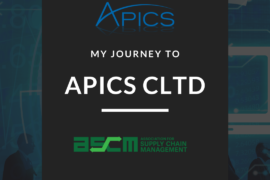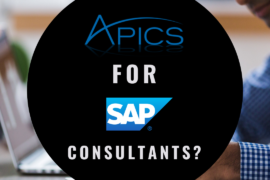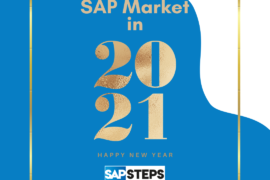I have been working in the SAP market for many years and I have always been much more focused on technology than really on the Supply Chain area itself (I am a consultant for the MM Module – a member of Supply Chain), however in 2020 I decided to change my focus a little and decided to start an MBA in the Supply Chain Area.
I confess that my initial expectation with the MBA was mainly to go deeper into the processes related to Supply Chain and to make a deeper connection between my technical knowledge with the business area.
However, to my surprise, in addition to this main objective, my biggest gain is in discovering new trends for the market as a whole and which, in my view, will bring a very significant impact to the SAP area (to the supply integrating modules).
I want to talk today about a topic that I didn’t even know existed about 2 months ago, but that, after hearing my teacher talk about it in one of the classes, I decided to buy 1 book (I’m reading the other, inclusive).
The theme is Circular Economy.
I was fascinated with the theme, mainly, because it is something that our society simply cannot “escape” in the medium / long term.
And why my fascination?
Because in addition to making tremendous sense (in terms of the survival of humanity), this trend will bring about such a big change in the way we produce, consume and dispose of everything we buy, that practically every day I wonder about the impact we will have on our processes within SAP projects.
What is the Circular Economy?
But after all, what is a Circular Economy.
I am not an expert on the subject, but I intend to pass on to you what I have understood so far about it.
When we think of Circular Economy, we are talking about a form of economy where, when thinking about launching a product, we already design it so that it is a “raw material” for the next product when its cycle comes to an end.
Seems complicated? I also think.
But think about this. Today, what is the main driver of our economy?
Produce and sell, correct?
But what will happen on the day that we no longer have raw materials to produce the products and sell them?
Some several studies and calculations show how we are exploring the environment in a totally unthinkable and irresponsible way.
If we continue to explore the environment and consume natural resources the way we do today, in addition to environmental problems (which are difficult to predict), our economy will collapse.
Just a parenthesis.
If you are curious to calculate how your personal consumption of natural resources is doing, there is a really cool calculator:
https://www.footprintcalculator.org/
Now, returning to this introduction, the main focus of the circular economy is to change the way we think about producing, consuming, and selling.
For example, a company may change its focus from selling a product to renting it.
When this change happens, the company will create a much more durable product, which is likely to be easier to maintain and which is likely to be used at the end of its life to produce a new product.
In doing so, we avoid dumping so much garbage in landfills and consuming as many raw materials as we do today.
A real-life example: Philips (https://www.philips.com/a-w/about/sustainability/circular-economy.html)
Philips has a service where it is responsible for selling the lighting “service” and not the lamps themselves.
With this change, she herself is responsible for maintaining and converting products.
In addition to the question of reuse, another very important point is the replacement of finite raw materials with ecologically renewable raw materials.
I am not an expert on the subject, but I was shocked when I read in that same book the example that Heinz (Manufacturing Ketchup) and Ford formed a partnership and created Bioplastico from tomatoes (https://www.telegraph.co.uk/business/successful-partnerships/Heinz-ford-tomato-fiber-bioplastic/), simply, incredible.
Imagine the amount of new raw materials that can be discovered if society starts to move towards this line?
In the book, several examples are shown.
Circular Economy and Money
I’m sure you must be thinking “pretty much the concept, but what about the financial part? Makes sense? And the impacts? ”
I thought exactly the same thing when I started to think about it.
When we think about changing our economy from a “sell” to a “rent” economy or for products that have much longer durability, there will be an impact.
Mainly a big cash flow impact.
Instead of receiving the full amount for a given product, the company will receive it in an “installment” manner, which can indeed impact the business a lot.
But, in my view, this is a change of mindset and a question of planning, because if it is planned with a long history, the change can be extremely positive, because in addition to having a continuous financial flow for the company, the relationship with the customer will be much closer and several other added products and services may be offered.
Circular Economy and SAP
And in the SAP area?
I see HUGE impacts.
I forgot to talk about another very cool point: the co-products.
Co-products are new products that are generated from a production process.
For example, a basic sanitation company may be cleaning water and as a co-product, it generates biogas that can be sold to another company.
This is another point in the concept of the circular economy: Zero waste.
Today, in some places in the world, industrial parks already exist, where a company produces a product and already has a structure to send a co-product directly to another company to use that product as raw material, with no need to even use a truck for this.
Going back to SAP, I want to list some examples of major impacts:
- Within the MM module, the control of raw materials.
- Within the QM module, several additional quality controls.
- Within the SD module, renting, returns, reverse logistics.
- Within the PP module, new production processes, a lot of control.
- Within the EWM module, new types of material movements.
- Within the FI and CO modules, new revenue streams, new costing components, etc.
We also have many impacts that are cross-module, such as:
- More complex material transfers.
- Freight planning.
- Complexity in launching new products.
- Major tax and accounting impacts.
- Etc.
I believe that you managed to understand how much we will have to change SAP projects.
The Book
Of course, I can’t help recommending the book to you.
The same is called Circular Economy and was written by Master in Logistics and Supply Chain Catherine Weetman and can be found on Amazon.
Highly recommended reading.
Conclusion
I hope you liked this post a little “different” from what I’m used to writing.
Honestly, I believe that this topic is extremely relevant to all people.
If you have any suggestions (including subjects you would like to read about), feel free to send an email to sapsteps@sapsteps.com.
A big hug,
Bruno César



